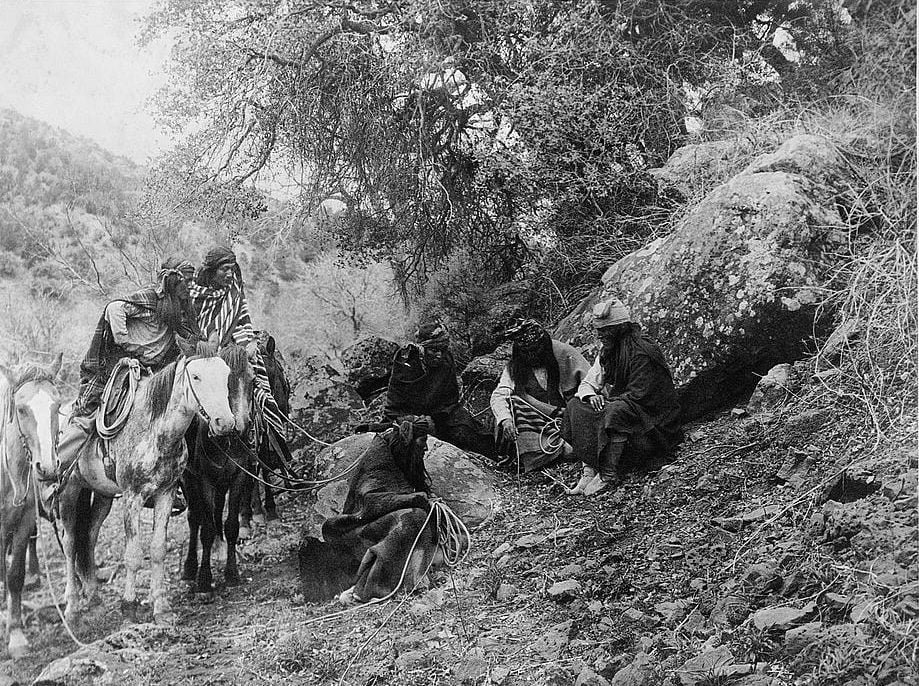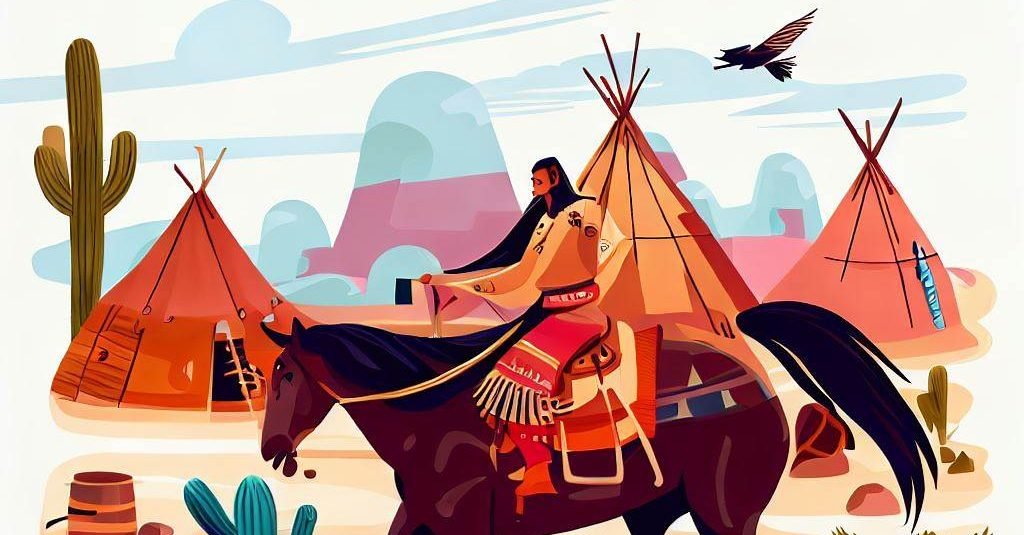The Apache history is a fascinating tale of perseverance and flexibility exhibited by several interrelated Native American tribes over centuries. From their early days of wandering to their challenges encountered during colonization and their subsequent revival in modern times, the Apache people have shown remarkable resilience. This article delves into the historical timeline of the Apache people, emphasizing significant moments and cultural practices that molded their unique identity. Additionally, we scrutinize their relationships with other tribes and societies, illuminating how these connections played a crucial role in their growth and evolution.
Pre-Contact Period

The Apache people are part of the Athabaskan-speaking group, with linguistic ties to other tribes in the Southwest, such as the Navajo. Anthropologists believe that the Apache migrated from present-day Canada and Alaska around 1000 AD. They settled in the American Southwest, primarily in present-day Arizona, New Mexico, Texas, and northern Mexico. While they did not have a centralized political structure, they shared a common language and culture.
The Apache were primarily nomadic hunter-gatherers, relying on seasonal movement to find food and resources. They hunted game like deer, antelope, and rabbits, and also gathered fruits, nuts, and seeds from the diverse flora of the Southwest. Their dwellings were temporary, made of materials like brush and animal hides, which could be easily disassembled and transported when it was time to move.
Apache society was organized into extended family groups called bands, which cooperated and occasionally fought with one another. Leadership was largely decentralized, with each band led by a respected elder or headman. Apache culture emphasized the importance of individual freedom, and leaders were expected to be skilled warriors and orators, with their positions earned through respect rather than inheritance.
Interactions with Other Tribes
The Apache’s nomadic lifestyle and decentralized political structure made them highly adaptable in their interactions with other tribes. They both traded and fought with neighboring tribes, including the Pueblo, Comanche, and Navajo. Through these interactions, the Apache adopted new practices and technologies, such as adopting horses from the Spanish, which transformed their way of life.
These relationships were not static and shifted over time, with alliances forming and dissolving as circumstances changed. For example, the Apache and Comanche initially had a hostile relationship due to competition for resources, but they later formed alliances against common enemies like the Spanish and American settlers. Similarly, the Apache’s interactions with the Pueblo and Navajo tribes were complex and multifaceted, with periods of cooperation and conflict driven by regional dynamics, resource competition, and political alliances.
By delving deeper into these relationships, we can better understand the complexity of the Apache’s social and political landscape, as well as the significance of these connections in shaping their culture and identity.
First Contact with Europeans
The first recorded encounter between the Apache and Europeans took place in 1540 when Spanish explorer Francisco Vázquez de Coronado came across them during his expedition in search of the mythical Seven Cities of Gold. Early interactions with the Spanish were mostly hostile, with the Apache fiercely defending their territory against the invaders.
As Spanish colonization expanded, so did the tensions between the two groups. The Apache began raiding Spanish settlements for livestock and other resources, and the Spanish retaliated with brutal military campaigns. These conflicts would set the stage for centuries of resistance against foreign domination.
The Apache Wars and Forced Relocation
In the mid-19th century, the United States began expanding westward, resulting in increased conflict between the Apache and American settlers. The Apache Wars, a series of conflicts that spanned from 1849 to 1886, saw the Apache defending their lands against the encroachment of settlers and the U.S. military.
The Apache Wars were driven by a range of factors, including land disputes, competition for resources, and the U.S. government’s expansionist policies. A more thorough examination of these underlying causes and motivations would help readers better understand the broader implications of these wars on the development of the United States and its relationship with Native American tribes.
The Apache were skilled guerrilla fighters, adept at using their knowledge of the terrain and ability to survive in harsh environments to their advantage. Despite their fierce resistance, the U.S. government pursued a policy of forced relocation, and many Apache were eventually confined to reservations.
Perhaps the most famous Apache leader during this time was Geronimo, who led a group of warriors in a protracted resistance against American forces. His eventual capture in 1886 marked the end of major armed conflict between the Apache and the United States.
The forced relocation to reservations had a devastating impact on the Apache people. Many were removed from their ancestral lands and placed on unfamiliar territory with limited resources. Disease, poverty, and cultural dislocation took a heavy toll on the Apache population.
Apache Resurgence and Contemporary Issues
Despite the challenges they faced, the Apache have shown incredible resilience in preserving their culture and maintaining their identity. In the early 20th century, the U.S. government instituted policies aimed at assimilating Native Americans into mainstream American society. The Apache resisted these attempts, and their cultural practices, such as the puberty ceremony called the Sunrise Dance, continued to be practiced on reservations.
In recent decades, the Apache have sought greater control over their lands and resources. Legal battles have been fought to protect sacred sites and to regain lost territory. Additionally, economic development on reservations has provided new opportunities for the Apache people, with industries such as tourism, gaming, and natural resource management creating jobs and generating revenue.
Today, the Apache continue to face challenges, including high rates of poverty and unemployment, historical trauma, and the ongoing struggle for self-determination. However, they also celebrate their heritage and work to ensure a brighter future for the next generation. The history of the Apache people is a testament to their strength, adaptability, and perseverance in the face of adversity.
Today the Apache Nation is split into five tribes:
- Yavapai-Apache Nation
- White Mountain Apache
- San Carlos Apache Nation
- Mescalero-Apache Nation
- Jicarillo-Apache Nation (no tribal website as of 4/8/23.)
Sources of Resilience and Adaptability
The Apache’s resilience and adaptability can be attributed to several factors, including their cultural practices, values, and belief systems. Their decentralized political structure and emphasis on individual freedom allowed for flexible responses to external threats and changing circumstances. Furthermore, their strong oral tradition and storytelling helped preserve their history and cultural knowledge, even during periods of upheaval and forced assimilation.
Understanding the specific cultural practices, values, and belief systems that have sustained the Apache people throughout their history offers valuable insights into the factors that have contributed to their endurance.
About Apache History
An in-depth exploration of Apache history reveals a complex tapestry of relationships with other tribes, encounters with European colonizers, and a long-standing commitment to preserving their culture and identity. By examining the various factors that have shaped their resilience and adaptability, we gain a more nuanced understanding of the rich history and culture of the Apache people. As they continue to face challenges in contemporary times, their story serves as a testament to the strength and perseverance of indigenous communities in the face of adversity.
Apache History Bibliography
- Basso, K. H. (1996). Wisdom sits in places: Landscape and language among the Western Apache. University of New Mexico Press.
- Debo, A. (1976). Geronimo: The man, his time, his place. University of Oklahoma Press.
- Goodwin, G. (1994). The social organization of the Western Apache. University of Arizona Press.
- Mails, Thomas E. (1974). The People Called Apache. Prentice-Hall Publishing.

